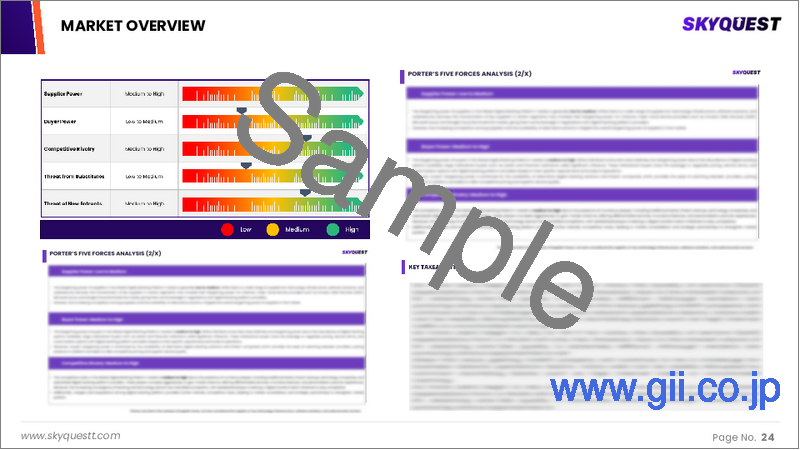|
|
市場調査レポート
商品コード
1654074
生パスタ市場規模、シェア、成長分析:タイプ別、用途別、流通チャネル別、地域別 - 産業予測 2025~2032年Fresh Pasta Market Size, Share, and Growth Analysis, By Type (Long Style Pasta, Short Style Pasta), By Application (Residential, Restaurant), By Distribution Channel, By Region - Industry Forecast 2025-2032 |
||||||
|
|||||||
| 生パスタ市場規模、シェア、成長分析:タイプ別、用途別、流通チャネル別、地域別 - 産業予測 2025~2032年 |
|
出版日: 2025年02月10日
発行: SkyQuest
ページ情報: 英文 157 Pages
納期: 3~5営業日
|
全表示
- 概要
- 目次
生パスタ市場規模は2023年に92億4,000万米ドルと評価され、2024年の98億1,000万米ドルから2032年には158億8,000万米ドルに成長し、予測期間(2025-2032年)のCAGRは6.2%で成長する見通しです。
世界の生パスタ市場は、コンビニエンス食品への消費者の嗜好の変化やイタリア料理への世界の親近感の高まりに後押しされ、大きな成長を遂げています。生パスタの魅力は、その高品質で本格的な性質と、従来の乾燥品種に比べ短時間で調理できる点にあります。欧州、特にイタリアが主要な生産国であることに変わりはないが、北米やアジア太平洋地域でもこの動向に拍車がかかっています。ライフスタイルが忙しくなるにつれて、調理済みまたは包装済みの生パスタに対する需要が高まり、品質と保存性を高めるための包装と保存の技術革新が促されています。市場の企業はまた、健康志向の消費者のニーズに応えるため、グルテンフリー、全粒粉、オーガニックの選択肢を導入し、小売店や外食産業との提携を通じて流通を拡大するなど、商品の多様化を進めています。
目次
イントロダクション
- 調査の目的
- 調査範囲
- 定義
調査手法
- 情報調達
- 二次と一次データの方法
- 市場規模予測
- 市場の前提条件と制限
エグゼクティブサマリー
- 世界市場の見通し
- 供給と需要の動向分析
- セグメント別機会分析
市場力学と見通し
- 市場概要
- 市場規模
- 市場力学
- 促進要因と機会
- 抑制要因と課題
- ポーターの分析
主な市場の考察
- 重要成功要因
- 競合の程度
- 主な投資機会
- 市場エコシステム
- 市場の魅力指数(2024年)
- PESTEL分析
- マクロ経済指標
- バリューチェーン分析
- 価格分析
生パスタ市場規模:タイプ別& CAGR(2025-2032)
- 市場概要
- ロングスタイルパスタ
- ショートスタイルパスタ
- 詰め物スタイルのパスタ
- その他
生パスタ市場規模:用途別& CAGR(2025-2032)
- 市場概要
- 住宅用
- レストラン
- 飛行機と電車
- その他
生パスタ市場規模:流通チャネル別& CAGR(2025-2032)
- 市場概要
- オフライン
- オンライン
生パスタ市場規模:地域別& CAGR(2025-2032)
- 北米
- 米国
- カナダ
- 欧州
- ドイツ
- スペイン
- フランス
- 英国
- イタリア
- その他欧州地域
- アジア太平洋地域
- 中国
- インド
- 日本
- 韓国
- その他アジア太平洋地域
- ラテンアメリカ
- ブラジル
- その他ラテンアメリカ地域
- 中東・アフリカ
- GCC諸国
- 南アフリカ
- その他中東・アフリカ
競合情報
- 上位5社の比較
- 主要企業の市場ポジショニング(2024年)
- 主な市場企業が採用した戦略
- 最近の市場動向
- 企業の市場シェア分析(2024年)
- 主要企業の企業プロファイル
- 企業の詳細
- 製品ポートフォリオ分析
- 企業のセグメント別シェア分析
- 収益の前年比比較(2022-2024)
主要企業プロファイル
- Barilla G. e R. Fratelli S.p.A.(Italy)
- Ebro Foods, S.A.(Spain)
- Nestle S.A.(Switzerland)
- F.lli De Cecco di Filippo Fara San Martino S.p.A.(Italy)
- JSC Makfa(Russia)
- AGT Food and Ingredients Inc.(Canada)
- General Mills, Inc.(United States)
- Conagra Brands, Inc.(United States)
- Quinoa Corporation(United States)
- Unilever(United Kingdom)
- Ajinomoto Co., Inc.(Japan)
- Thai President Foods Public Company Limited(Thailand)
- ITC Limited(India)
- Bambino Agro Industries Limited(India)
- Granarolo S.p.A.(Italy)
- Hilcona AG(Liechtenstein)
- Armanino Foods of Distinction(United States)
結論と提言
Fresh Pasta Market size was valued at USD 9.24 billion in 2023 and is poised to grow from USD 9.81 billion in 2024 to USD 15.88 billion by 2032, growing at a CAGR of 6.2% during the forecast period (2025-2032).
The global fresh pasta market is experiencing significant growth fueled by shifting consumer preferences towards convenience foods and the increasing global affinity for Italian cuisine. Fresh pasta's appeal lies in its high-quality, authentic nature, and quicker cooking times compared to traditional dried varieties. While Europe, particularly Italy, remains a major producer, the trend is gaining momentum in North America and Asia-Pacific, reflecting its versatility as a meal choice. As lifestyles become busier, the demand for ready-to-cook or pre-packaged fresh pasta is rising, prompting innovations in packaging and preservation to enhance quality and shelf life. Market players are also diversifying their offerings, introducing gluten-free, whole wheat, and organic options to meet the needs of health-conscious consumers and expanding distribution through retail and foodservice collaborations.
Top-down and bottom-up approaches were used to estimate and validate the size of the Fresh Pasta market and to estimate the size of various other dependent submarkets. The research methodology used to estimate the market size includes the following details: The key players in the market were identified through secondary research, and their market shares in the respective regions were determined through primary and secondary research. This entire procedure includes the study of the annual and financial reports of the top market players and extensive interviews for key insights from industry leaders such as CEOs, VPs, directors, and marketing executives. All percentage shares split, and breakdowns were determined using secondary sources and verified through Primary sources. All possible parameters that affect the markets covered in this research study have been accounted for, viewed in extensive detail, verified through primary research, and analyzed to get the final quantitative and qualitative data.
Fresh Pasta Market Segments Analysis
Global Fresh Pasta Market is segmented by Type, Application, Distribution Channel and region. Based on Type, the market is segmented into Long Style Pasta, Short Style Pasta, Filled Style Pasta and Others. Based on Application, the market is segmented into Residential, Restaurant, Airplane & Train and Others. Based on Distribution Channel, the market is segmented into Offline and Online. Based on region, the market is segmented into North America, Europe, Asia Pacific, Latin America and Middle East & Africa.
Driver of the Fresh Pasta Market
The expansion of the global fresh pasta market is largely fueled by an increasing appetite for convenient and time-efficient food solutions. As modern consumers lead busier lives, the appeal of fresh pasta lies in its ability to provide quick, ready-to-eat, or easy-to-cook meal options. This trend is further exacerbated by urbanization and evolving lifestyles, which encourage a preference for convenient food alternatives. As a result, the consumption of fresh pasta continues to rise, reflecting a significant shift in consumer behavior towards meals that enhance convenience without sacrificing taste or quality.
Restraints in the Fresh Pasta Market
The fresh pasta market faces significant restraints primarily due to its perishable nature, attributed to high moisture levels. This characteristic complicates aspects like transportation, storage, and overall shelf life. As a result, consumers are often inclined towards dried or frozen pasta varieties that offer extended shelf lives, which can negatively impact the demand for fresh pasta. Additionally, maintaining freshness and preventing spoilage during distribution processes presents a critical challenge for manufacturers. The need for effective preservation methods and efficient supply chain management is essential to navigate these hurdles and sustain market presence in an increasingly competitive landscape.
Market Trends of the Fresh Pasta Market
The fresh pasta market is experiencing a notable trend driven by the increasing demand for convenient and ready-to-cook meal solutions. As consumers embrace busier lifestyles and seek quality food options that require minimal preparation time, fresh pasta serves as an ideal choice. This shift has prompted manufacturers to invest in innovative packaging, portion control, and extended shelf-life technologies to enhance the product's appeal. Moreover, the market is adapting to health-conscious consumers by incorporating healthier ingredients and dietary alternatives, aligning with the rising focus on nutrition. This combination of convenience and quality positions the fresh pasta market for sustained growth in the coming years.
Table of Contents
Introduction
- Objectives of the Study
- Scope of the Report
- Definitions
Research Methodology
- Information Procurement
- Secondary & Primary Data Methods
- Market Size Estimation
- Market Assumptions & Limitations
Executive Summary
- Global Market Outlook
- Supply & Demand Trend Analysis
- Segmental Opportunity Analysis
Market Dynamics & Outlook
- Market Overview
- Market Size
- Market Dynamics
- Drivers & Opportunities
- Restraints & Challenges
- Porters Analysis
- Competitive rivalry
- Threat of substitute
- Bargaining power of buyers
- Threat of new entrants
- Bargaining power of suppliers
Key Market Insights
- Key Success Factors
- Degree of Competition
- Top Investment Pockets
- Market Ecosystem
- Market Attractiveness Index, 2024
- PESTEL Analysis
- Macro-Economic Indicators
- Value Chain Analysis
- Pricing Analysis
Global Fresh Pasta Market Size by Type & CAGR (2025-2032)
- Market Overview
- Long Style Pasta
- Short Style Pasta
- Filled Style Pasta
- Others
Global Fresh Pasta Market Size by Application & CAGR (2025-2032)
- Market Overview
- Residential
- Restaurant
- Airplane & Train
- Others
Global Fresh Pasta Market Size by Distribution Channel & CAGR (2025-2032)
- Market Overview
- Offline
- Online
Global Fresh Pasta Market Size & CAGR (2025-2032)
- North America (Type, Application, Distribution Channel)
- US
- Canada
- Europe (Type, Application, Distribution Channel)
- Germany
- Spain
- France
- UK
- Italy
- Rest of Europe
- Asia Pacific (Type, Application, Distribution Channel)
- China
- India
- Japan
- South Korea
- Rest of Asia-Pacific
- Latin America (Type, Application, Distribution Channel)
- Brazil
- Rest of Latin America
- Middle East & Africa (Type, Application, Distribution Channel)
- GCC Countries
- South Africa
- Rest of Middle East & Africa
Competitive Intelligence
- Top 5 Player Comparison
- Market Positioning of Key Players, 2024
- Strategies Adopted by Key Market Players
- Recent Developments in the Market
- Company Market Share Analysis, 2024
- Company Profiles of All Key Players
- Company Details
- Product Portfolio Analysis
- Company's Segmental Share Analysis
- Revenue Y-O-Y Comparison (2022-2024)
Key Company Profiles
- Barilla G. e R. Fratelli S.p.A. (Italy)
- Company Overview
- Business Segment Overview
- Financial Updates
- Key Developments
- Ebro Foods, S.A. (Spain)
- Company Overview
- Business Segment Overview
- Financial Updates
- Key Developments
- Nestle S.A. (Switzerland)
- Company Overview
- Business Segment Overview
- Financial Updates
- Key Developments
- F.lli De Cecco di Filippo Fara San Martino S.p.A. (Italy)
- Company Overview
- Business Segment Overview
- Financial Updates
- Key Developments
- JSC Makfa (Russia)
- Company Overview
- Business Segment Overview
- Financial Updates
- Key Developments
- AGT Food and Ingredients Inc. (Canada)
- Company Overview
- Business Segment Overview
- Financial Updates
- Key Developments
- General Mills, Inc. (United States)
- Company Overview
- Business Segment Overview
- Financial Updates
- Key Developments
- Conagra Brands, Inc. (United States)
- Company Overview
- Business Segment Overview
- Financial Updates
- Key Developments
- Quinoa Corporation (United States)
- Company Overview
- Business Segment Overview
- Financial Updates
- Key Developments
- Unilever (United Kingdom)
- Company Overview
- Business Segment Overview
- Financial Updates
- Key Developments
- Ajinomoto Co., Inc. (Japan)
- Company Overview
- Business Segment Overview
- Financial Updates
- Key Developments
- Thai President Foods Public Company Limited (Thailand)
- Company Overview
- Business Segment Overview
- Financial Updates
- Key Developments
- ITC Limited (India)
- Company Overview
- Business Segment Overview
- Financial Updates
- Key Developments
- Bambino Agro Industries Limited (India)
- Company Overview
- Business Segment Overview
- Financial Updates
- Key Developments
- Granarolo S.p.A. (Italy)
- Company Overview
- Business Segment Overview
- Financial Updates
- Key Developments
- Hilcona AG (Liechtenstein)
- Company Overview
- Business Segment Overview
- Financial Updates
- Key Developments
- Armanino Foods of Distinction (United States)
- Company Overview
- Business Segment Overview
- Financial Updates
- Key Developments





